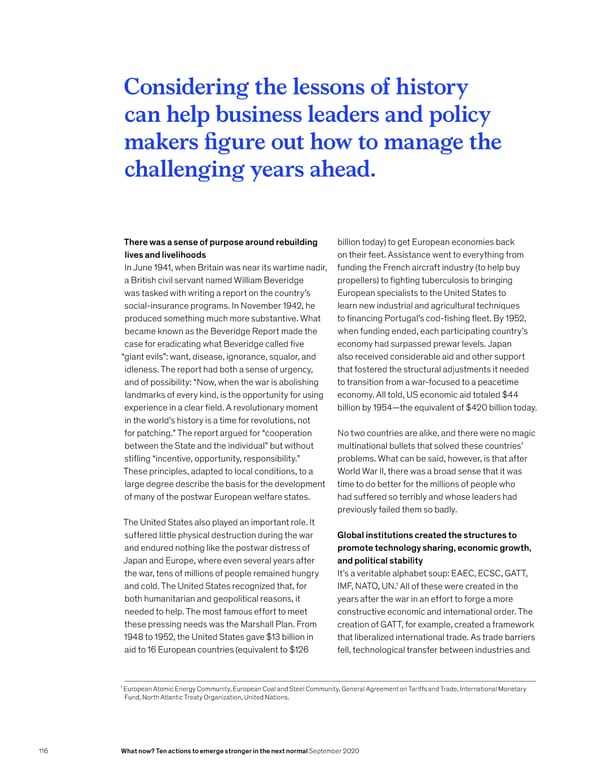Considering the lessons of history can help business leaders and policy makers figure out how to manage the challenging years ahead. There was a sense of purpose around rebuilding billion today) to get European economies back lives and livelihoods on their feet. Assistance went to everything from In June 1941, when Britain was near its wartime nadir, funding the French aircraft industry (to help buy a British civil servant named William Beveridge propellers) to fighting tuberculosis to bringing was tasked with writing a report on the country’s European specialists to the United States to social-insurance programs. In November 1942, he learn new industrial and agricultural techniques produced something much more substantive. What to financing Portugal’s cod-fishing fleet. By 1952, became known as the Beveridge Report made the when funding ended, each participating country’s case for eradicating what Beveridge called five economy had surpassed prewar levels. Japan “giant evils”: want, disease, ignorance, squalor, and also received considerable aid and other support idleness. The report had both a sense of urgency, that fostered the structural adjustments it needed and of possibility: “Now, when the war is abolishing to transition from a war-focused to a peacetime landmarks of every kind, is the opportunity for using economy. All told, US economic aid totaled $44 experience in a clear field. A revolutionary moment billion by 1954—the equivalent of $420 billion today. in the world’s history is a time for revolutions, not for patching.” The report argued for “cooperation No two countries are alike, and there were no magic between the State and the individual” but without multinational bullets that solved these countries’ stifling “incentive, opportunity, responsibility.” problems. What can be said, however, is that after These principles, adapted to local conditions, to a World War II, there was a broad sense that it was large degree describe the basis for the development time to do better for the millions of people who of many of the postwar European welfare states. had suffered so terribly and whose leaders had previously failed them so badly. The United States also played an important role. It suffered little physical destruction during the war Global institutions created the structures to and endured nothing like the postwar distress of promote technology sharing, economic growth, Japan and Europe, where even several years after and political stability the war, tens of millions of people remained hungry It’s a veritable alphabet soup: EAEC, ECSC, GATT, and cold. The United States recognized that, for 1 IMF, NATO, UN. All of these were created in the both humanitarian and geopolitical reasons, it years after the war in an effort to forge a more needed to help. The most famous effort to meet constructive economic and international order. The these pressing needs was the Marshall Plan. From creation of GATT, for example, created a framework 1948 to 1952, the United States gave $13 billion in that liberalized international trade. As trade barriers aid to 16 European countries (equivalent to $126 fell, technological transfer between industries and 1 European Atomic Energy Community, European Coal and Steel Community, General Agreement on Tariffs and Trade, International Monetary Fund, North Atlantic Treaty Organization, United Nations. 116 What now? Ten actions to emerge stronger in the next normal September 2020
 What Now? Page 117 Page 119
What Now? Page 117 Page 119